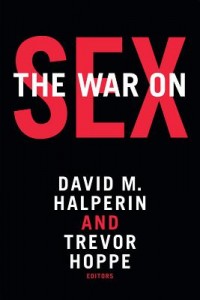 Porno Chic and the Sex Wars: American Sexual Representation in the 1970s
Porno Chic and the Sex Wars: American Sexual Representation in the 1970s
Edited by Carolyn Bronstein and Whitney Strub
University of Massachusetts Press. 352 pages, $28.95
 The War on Sex
The War on Sex
Edited by David M. Halperin and Trevor Hoppe
Duke University Press. 512 pages, $29.33
THESE TWO THICK ANTHOLOGIES tell a story of increasing sexual repression in the U.S. since the late 1970s. Despite improvements in the legal and social status of LGBT citizens, the consensual sex lives of Americans are more policed now than ever before. The evidence is impossible to deny, and it is one of the reasons why prisons in the U.S. are overflowing with nonviolent “offenders,” and why many of them will never find jobs, housing, or social acceptance after their release. It seems that traditional state homophobia and patriarchal control of women never really went away. It simply changed form into panicked efforts to “protect” teenagers from all sexual experimentation, to criminalize HIV-positive status, and to destroy the sex trade.
These two books tell a chronological story if read in the right order. Porno Chic and the Sex Wars describes the decline of the American economy in the early 1970s and the corresponding decay in “inner cities.” Times Square in New York became a mecca for sexually-oriented businesses, including movie theaters that showed sex films at a time before the Internet and the video rental business. At the same time, neighborhoods such as the Castro in San Francisco were increasingly occupied by young LGBT refugees from Small Town U.S.A. The rise of pornographic films and magazines, a few of which achieved mainstream status, coincided with the rise of a visible gay community. In fact, there was more overlap between homosexuality and sex work than is usually acknowledged today.
Of course, there were problems with the utopian visions expressed in the pornography of the time. Heterosexual plots in films and photo spreads in print media often showed male violence against women, who were shown responding ecstatically. Films featuring sex between men were usually about anonymous cruising in a dangerous urban environment, while lesbianism, when shown, was usually part of a subplot about women who get their greatest sexual satisfaction from men. While the surprising mainstream success of the cheaply made film Deep Throat (1972) can be seen as a brief moment of sexual openness in American culture, the male-centered premise—a young woman can only have orgasms when giving blow jobs—shows that the “sexual freedom” of the time was not even assumed to apply equally to all adults.
In Porno Chic, several contributors trace the influence of traditional homophobia on the “kiddie-porn panic” of the late 1970s. This was the era of Anita Bryant’s campaign to repeal gay rights legislation in Florida with claims that gay rights endangered children, especially boys. Greg Youmans claims that “the child sexual endangerment panic of the late 1970s focused inordinately on ‘stranger danger,’ threats from pedophiles lurking outside the home, despite the far greater prevalence of child sexual abuse perpetrated by family members and others known to the victim.” The prevalence of this image of predatory urban pedophiles goes a long way toward explaining Bryant’s success in this campaign.
The War on Sex continues the story of interrelated “sex panics” that continued to result in new legislation in the 1980s and beyond. While campaigns against “perverts” as corrupters of the young have disproportionately targeted men, campaigns against prostitution disproportionately target women as voiceless “victims” who need legal intervention, as well as men of color as “traffickers,” thus linking Victorian-style moral reform with racism and anti-immigrant nationalism. A moving essay by Melissa Petro, the public-school teacher who became known as “the Craigslist hooker,” explores the stigma and job loss faced by former sex-workers even after they have entered “respectable” careers.
In a section on the criminalization of HIV status, several contributors show that long prison sentences have been given to HIV-positive men and women for having protected, consensual sex. The legal basis of these sentences is that non-disclosure of one’s viral status is a crime, and so is potential transmission. The purpose of these laws seems to be to force the HIV-positive population to give up sex altogether.
Both of these books show how the feminist and gay rights movements of the 1970s, with their analyses of systemic sexism and homophobia and their visions of freedom and pleasure, have been subverted by right-wing movements based on “family values.” White, well-educated, professional gay men and lesbians are shown to have achieved some degree of mainstream acceptance at the expense of sexually defined populations that are now more vulnerable to legal and social persecution than ever before.
________________________________________________________
Jean Roberta is a widely published writer based in Regina, Canada.





